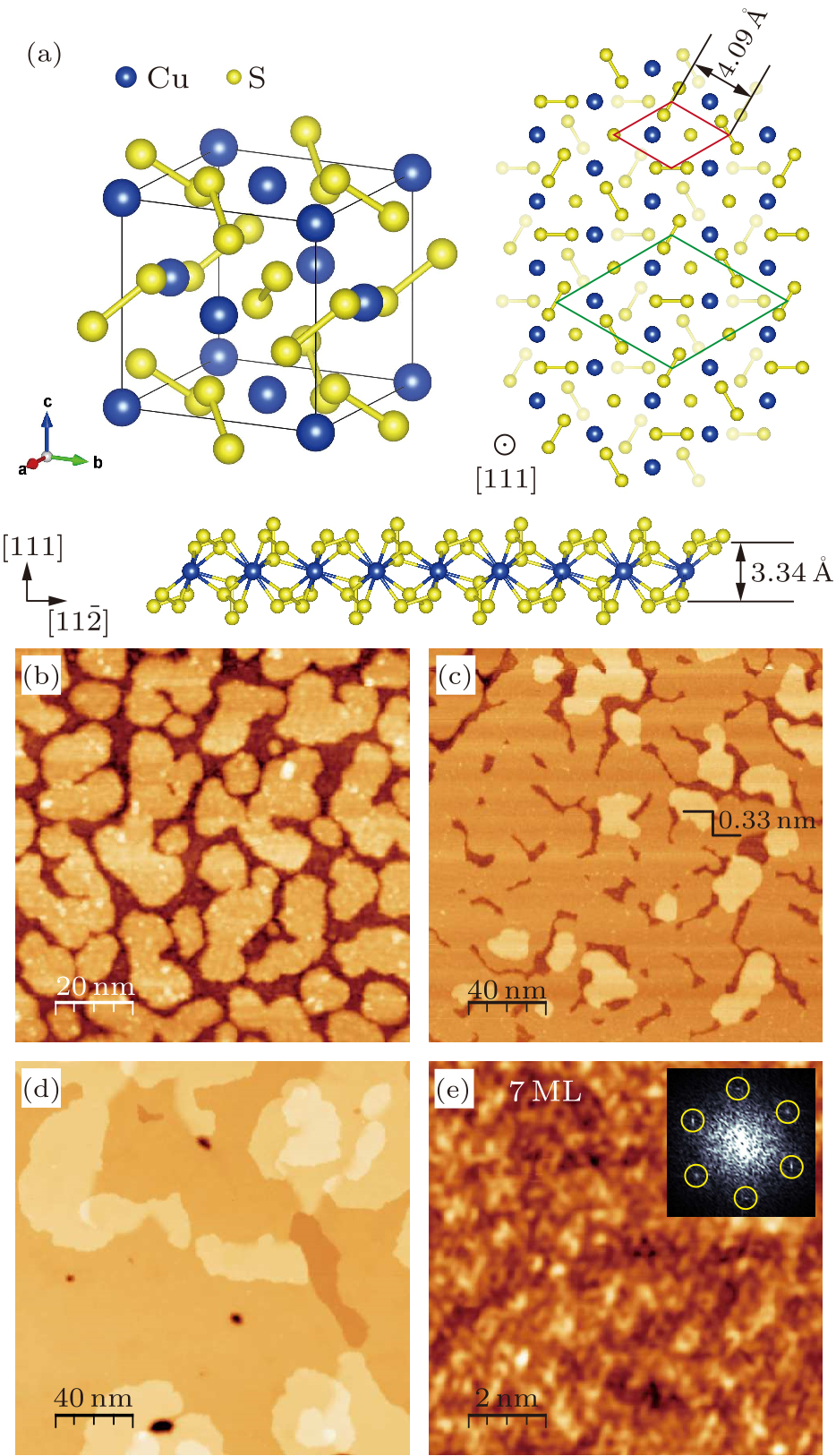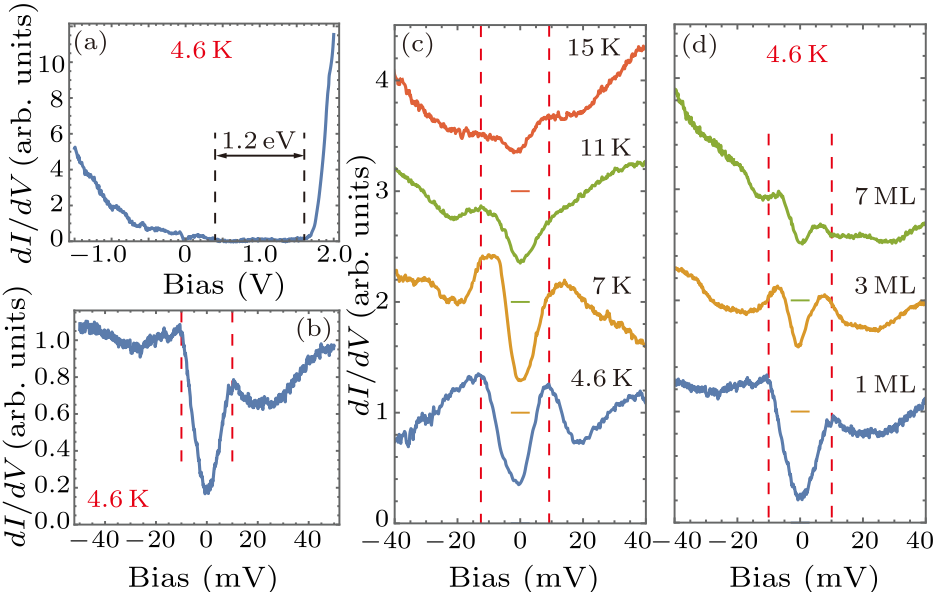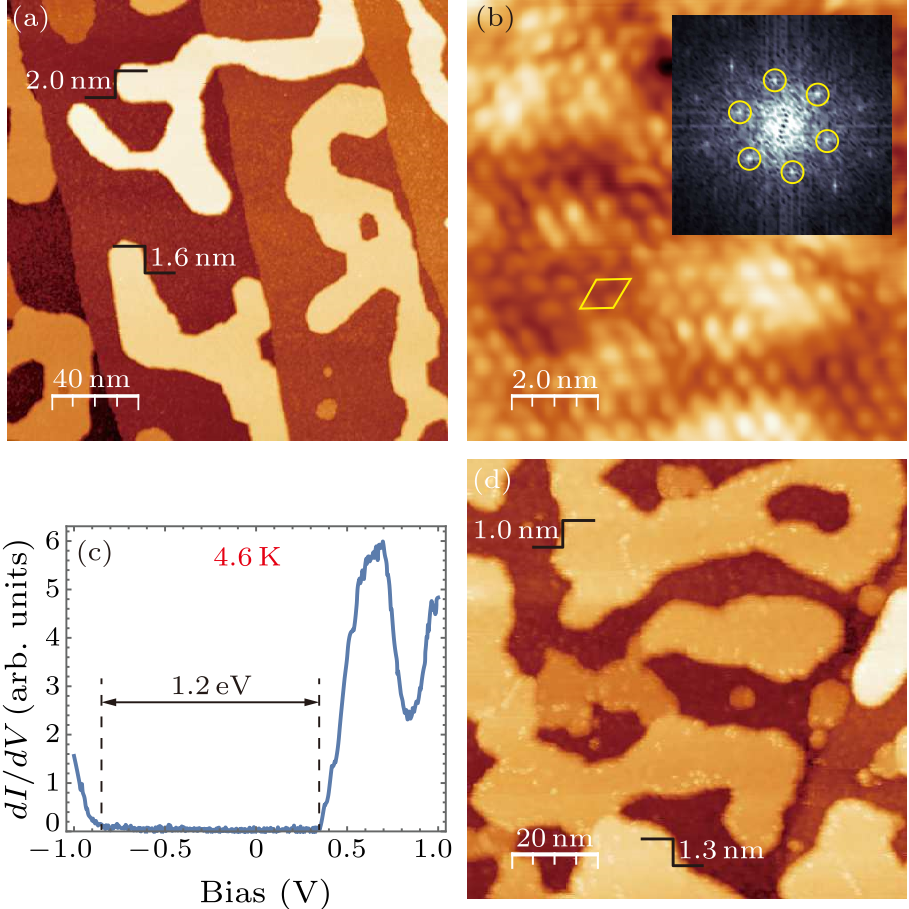
Fig. 1. (a) Crystal structure of pyrite CuS$_{2}$. (b)–(e) STM topographic images of CuS$_{2}$ on SrTiO$_{3}$(001) at various nominal coverages: (b) 0.7 ML ($V_{\rm s}=5$ V, $I=50$ pA), (c) 1 ML ($V_{\rm s}=4.5$ V, $I=40$ pA), and (d)–(e) 7 ML ((d) $V_{\rm s}=6$ V, $I=50$ pA and (e) $V_{\rm s}=0.4$ V, $I=100$ pA). The inset in (e) is the corresponding FFT images with the yellow circles marking the 1$\times$1 Bragg points.

Fig. 2. (a) and (b) $dI/dV$ tunneling spectra taken on 1 ML CuS$_{2}$ films on SrTiO$_{3}$(001) ((a) $V_{\rm s}=2$ V, $I=100$ pA; (b) $V_{\rm s}=-50$ mV, $I=100$ pA). (c) Tunneling spectra taken on 1 ML films at various temperatures ($V_{\rm s}=60$ mV, $I=100$ pA). (d) Tunneling spectra taken on films with various thickness: 1 ML ($V_{\rm s}=-50$ mV, $I=100$ pA), 3 ML ($V_{\rm s}=-60$ mV, $I=200$ pA) and 7 ML ($V_{\rm s}=60$ mV, $I=100$ pA). The spectra in (c) and (d) are shifted along the vertical axis. The horizontal bars indicate the zero-conductance position of each curve. The black dashed lines in (a) show the band gap. The red dashed lines in (b)–(d) are guide for eyes, showing the change of tunneling gap.

Fig. 3. (a)–(b) Topographic image of 1 ML CuS$_{2}$ after being annealed at 200$^\circ\!$C ((a) $V_{\rm s}=2.5$ V, $I=50$ pA; (b) $V_{\rm s}=1.3$ V, $I=200$ pA). In (b), the yellow rhombus labels the unit cell. The inset is the corresponding FFT images showing reconstruction, as labelled by the yellow circles. (c) $dI/dV$ tunneling spectra taken on CuS$_{2}$ islands on SrTiO$_{3}$(001) ($V_{\rm s}=1$ V, $I=100$ pA). The black dashed lines show the band gap. (d) Topographic image of 1 ML CuS$_{2}$ after being annealed under S flux at 60$^\circ\!$C ($V_{\rm s}=3$ V, $I=50$ pA).

Fig. 4. (a) Topographic image of as-cleaved Bi-2212 ($V_{\rm s}=0.6$ V, $I=100$ pA). (b) and (c) Topographic images of CuS$_{2}$ grown on Bi-2212 with nominal coverage of 1 ML ((b) $V_{\rm s}=3$ V, $I=50$ pA; (c) $V_{\rm s}=0.5$ V, $I=100$ pA). The inset of (c) is the FFT image showing reconstruction as labeled by the yellow circles. (d) Tunneling spectrum taken on exposed Bi-2212 after the growth of CuS$_{2}$ ($V_{\rm s}=-0.2$ V, $I=100$ pA). (e) and (f) Tunneling spectra taken on 1 ML CuS$_{2}$ on Bi-2212 ((e) $V_{\rm s}=-1$ V, $I=50$ pA; (f) $V_{\rm s}=-50$ mV, $I=100$ pA). The red dashed lines in (d) and (f) show coherence peaks of the tunneling gaps.
| [1] | Xu X, Yao W, Xiao D and Heinz T F 2014 Nat. Phys. 10 343 | Spin and pseudospins in layered transition metal dichalcogenides
| [2] | Navarro-Moratalla E, Island J O, Mañas Valero S, Pinilla-Cienfuegos E, Castellanos-Gomez A, Quereda J, Rubio-Bollinger G, Chirolli L, Silva-Guillen J A, Agrait N, Steele G A, Guinea F, van der Zant H S and Coronado E 2016 Nat. Commun. 7 11043 | Enhanced superconductivity in atomically thin TaS2
| [3] | Wang Q Y, Li Z, Zhang W H, Zhang Z C, Zhang J S, Li W, Ding H, Ou Y B, Deng P, Chang K, Wen J, Song C L, He K, Jia J F, Ji S H, Wang Y Y, Wang L, Chen X, Ma X C and Xue Q K 2012 Chin. Phys. Lett. 29 037402 | Interface-Induced High-Temperature Superconductivity in Single Unit-Cell FeSe Films on SrTiO 3
| [4] | Wang L, Ma X C and Xue Q K 2016 Supercond. Sci. Technol. 29 123001 | Interface high-temperature superconductivity
| [5] | Wang L and Xue Q K 2017 AAPPS Bull. 27 3 | High Temperature Superconductivity in Single-Unit-Cell-FeSe/TiO2-δ
| [6] | Bither T A, Bouchard R J, Cloud W H, Dokohue P C and Siemoks W J 1968 Inorg. Chem. 7 2208 | Transition metal pyrite dichalcogenides. High-pressure synthesis and correlation of properties
| [7] | Krill G, Panissod P, Lapierre M F, Gautier F, Robert C and Eddinetg M N 1976 J. Phys. C 9 1521 | Magnetic properties and phase transitions of the metallic CuX 2 dichalcogenides (X=S, Se, Te) with pyrite structure
| [8] | Kontani M, Tutui T, Moriwaka T and Mizukoshi T 2000 Physica B 284-288 675 | Specific heat and NMR studies on the pyrite-type superconductors CuS2 and CuSe2
| [9] | Bither T A, Prewitt C T, Gillson J L, Bierstedt P E, Flippen R B and Young H S 1966 Solid State Commun. 4 533 | New transition metal dichalcogenides formed at high pressure
| [10] | Munson R A, DeSorbo W and Kouvel J S 1967 J. Chem. Phys. 47 1769 | Electrical, Magnetic, and Superconducting Properties of Copper Disulfide
| [11] | Ueda H, Nohara M, Kitazawa K, Takagi H, Fujimori A, Mizokawa T and Yagi T 2002 Phys. Rev. B 65 155104 | Copper pyrites and as anion conductors
| [12] | Hou Z, Li A, Zhu Z and Huang M 2004 J. Mater. Sci. Technol. 20 429 |
| [13] | Brunetti B, Piacente V and Scardala P 1994 J. Alloy. Compd. 206 113 | Study on sulfur vaporization from covellite (CuS) and anilite (Cu1.75S)
| [14] | Ohtomo A and Hwang H 2004 Nature 427 423 | A high-mobility electron gas at the LaAlO3/SrTiO3 heterointerface
| [15] | Peng J P, Zhang H M, Song C L, Jiang Y P, Wang L, He K, Xue Q K and Ma X C 2015 Chin. Phys. Lett. 32 068104 | Molecular Beam Epitaxy Growth and Scanning Tunneling Microscopy Study of Pyrite CuSe 2 Films on SrTiO 3
| [16] | Butko V Y, DiTusa J F and Adams P W 2000 Phys. Rev. Lett. 84 1543 | Coulomb Gap: How a Metal Film Becomes an Insulator